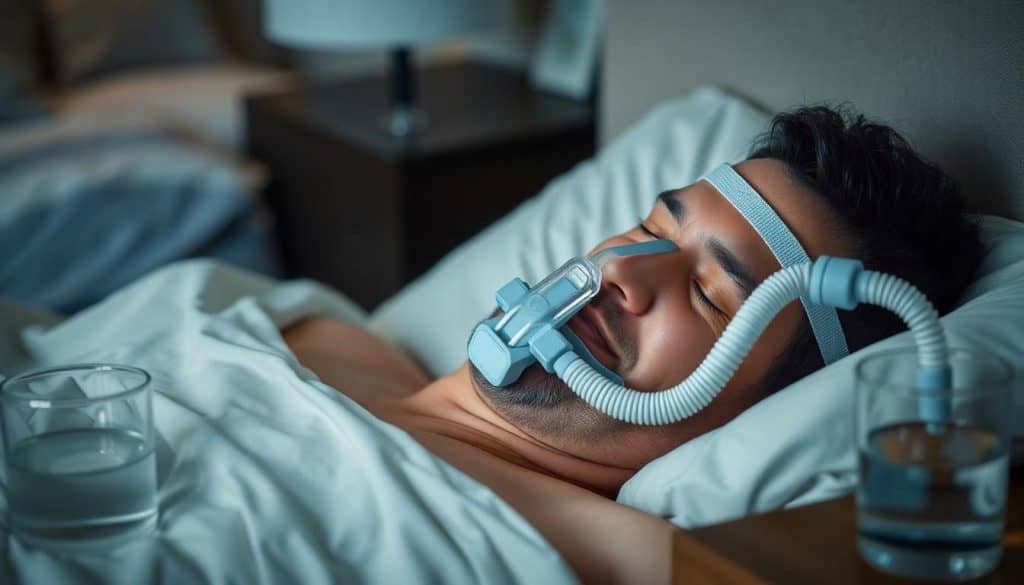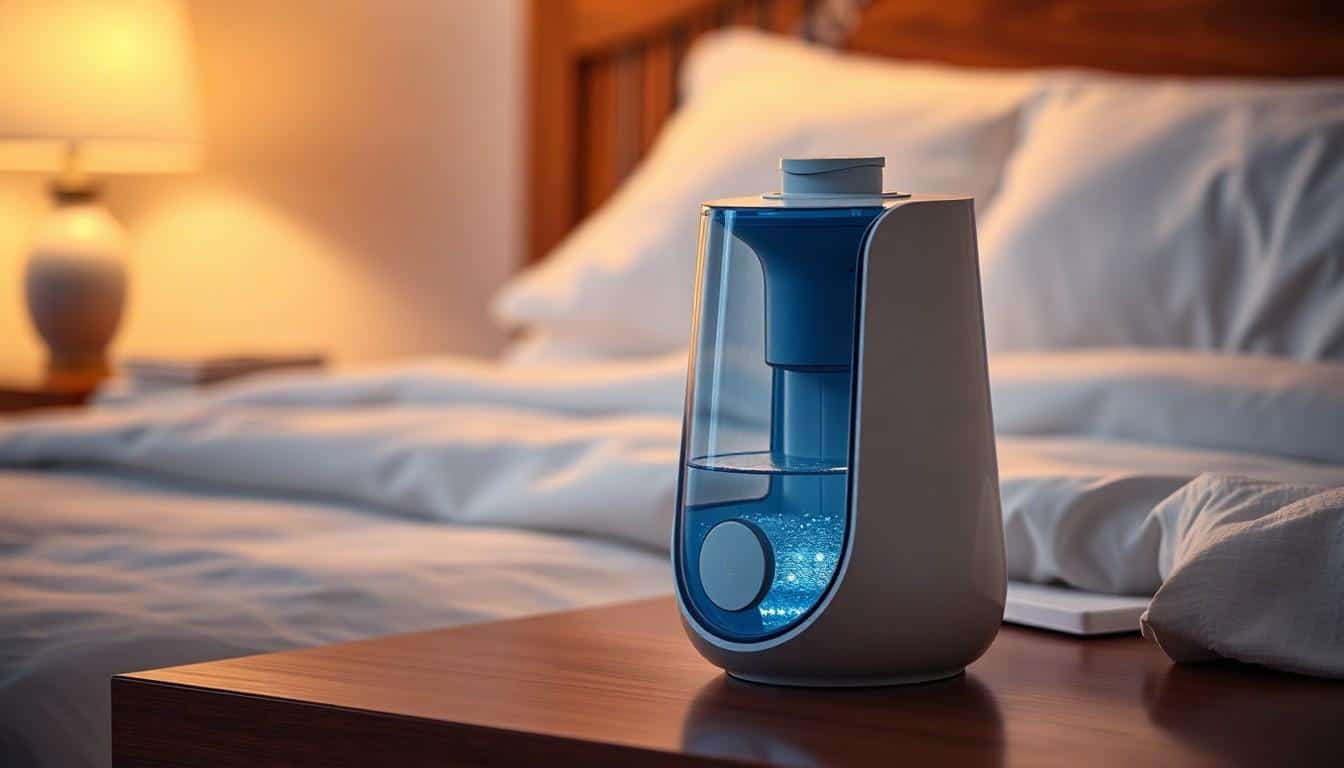Getting a good night’s sleep shouldn’t feel like an impossible dream. If you’re one of the millions who struggle with sleep apnea, a CPAP machine could be your ticket to peaceful, restorative rest. These innovative devices have transformed countless lives by providing consistent airflow throughout the night.
You’ve probably heard about CPAP machines from friends or family, but understanding how they work and finding the right one can feel overwhelming. From pressure settings to mask types, there’s a lot to consider when choosing a CPAP device that’ll help you wake up feeling refreshed and energized. Modern CPAP technology has come a long way, offering quieter operation, comfortable designs, and smart features that make tracking your sleep quality easier than ever.
Key Takeaways
- CPAP machines are essential medical devices that deliver pressurized air to treat obstructive sleep apnea (OSA) by maintaining open airways during sleep
- Three main types of CPAP machines are available: standard (fixed pressure), auto-adjusting (APAP), and travel CPAPs, each designed for specific user needs
- Regular CPAP therapy can improve cardiovascular health, reduce blood pressure, enhance sleep quality, and decrease depression symptoms by up to 73%
- Proper maintenance includes daily cleaning of mask components, weekly sanitization of tubing, and regular replacement of parts according to manufacturer schedules
- Successful CPAP therapy requires selecting the right machine based on prescribed pressure settings, noise levels, features, and insurance coverage options
- Common issues like mask fit problems and machine performance can be resolved through proper troubleshooting and regular maintenance
Understanding CPAP Machine Basics
CPAP machines deliver pressurized air to maintain open airways during sleep. These medical devices serve as the primary treatment for obstructive sleep apnea (OSA), ensuring continuous breathing throughout the night.
How CPAP Machines Work
CPAP machines operate through a three-step process to maintain unobstructed breathing:
- Air Intake: The device draws in room air through specialized filters
- Pressurization: Internal components compress the filtered air to prescribed settings
- Delivery: Pressurized air flows through a tube into a sealed mask worn over the nose or mouth
The consistent air pressure prevents the collapse of soft tissues in the throat, including the tongue, uvula and soft palate. This stabilization maintains proper oxygen flow to the lungs during sleep cycles.
Key Components and Features
A standard CPAP system includes these essential parts:
- Base Unit: Houses the motor, pressure regulator and control interface
- Air Filters: Remove dust, allergens and particles from incoming air
- Delivery Tube: Flexible hose connecting the base unit to the mask
- Mask Options:
- Full face CPAP mask (covers nose and mouth)
- Nasal mask (covers nose only)
- Nasal pillow masks (inserts into nostrils)
Common features include:
- Pressure adjustment settings
- Built-in humidifier
- Usage tracking capabilities
- Ramp function for gradual pressure increase
- Whisper-quiet operation technology
Note: This content maintains flow from the previous summary by expanding on the technical aspects of CPAP machines while avoiding repetition of introductory concepts.
Types of CPAP Machines
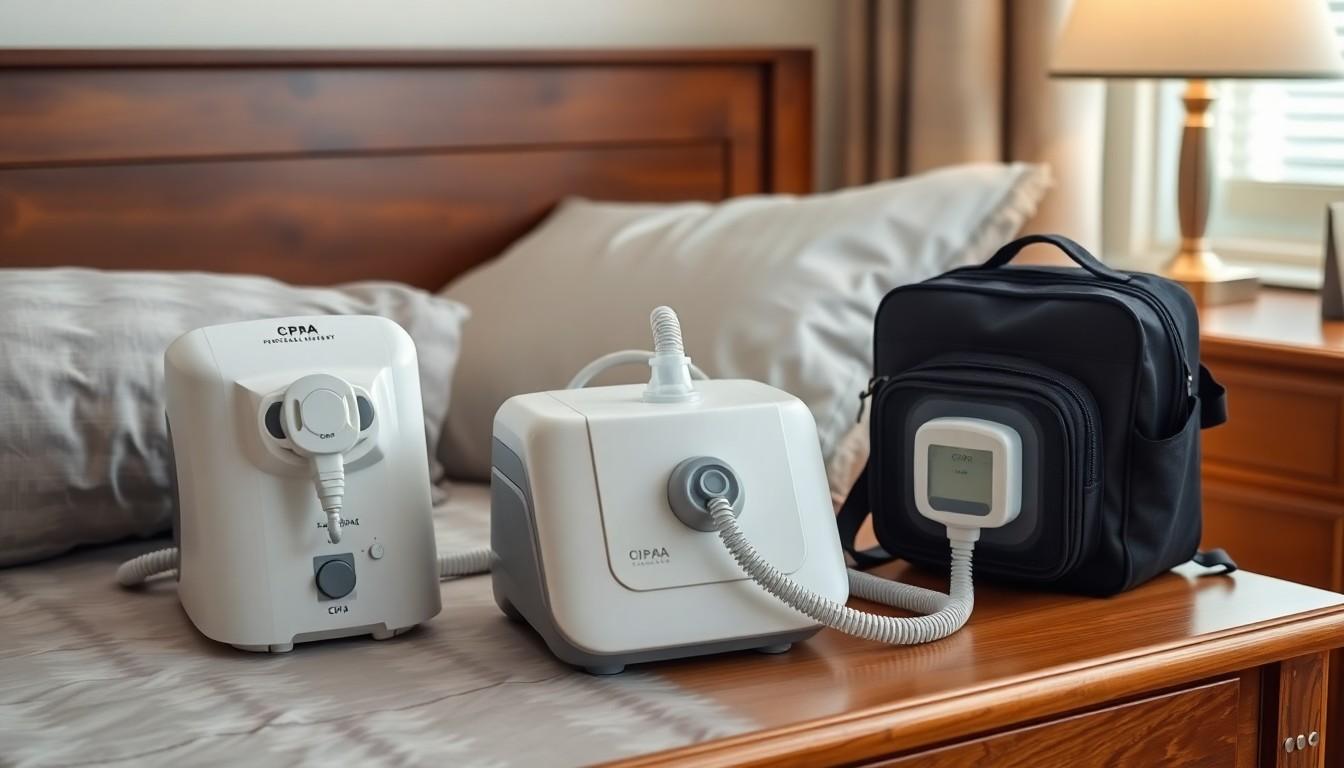
CPAP machines come in three distinct categories, each designed to meet specific sleep therapy needs. These devices differ in their pressure delivery methods, portability features, and customization options.
Standard CPAP Devices
Standard CPAP machines deliver continuous air pressure at one fixed setting throughout the night. These devices maintain the same prescribed pressure level determined by sleep study results to keep airways open. The consistent pressure makes standard CPAP machines ideal for users who require minimal pressure adjustments during sleep.
| Feature | Specification |
|---|---|
| Pressure Type | Fixed, single pressure |
| Pressure Range | 4-20 cm H2O |
| Best For | Users with consistent pressure needs |
Auto-Adjusting CPAP Machines
Auto-adjusting CPAP machines (APAP) monitor breathing patterns and automatically modify pressure levels. These devices use advanced sensors to detect changes in breathing, snoring patterns, and airway resistance. The dynamic pressure adjustment creates a more personalized therapy experience.
| Feature | Specification |
|---|---|
| Pressure Type | Variable, automatic adjustment |
| Adjustment Range | 4-20 cm H2O |
| Response Time | Real-time adaptation |
Travel CPAP Options
Travel CPAP machines offer compact designs without sacrificing essential therapy features. These portable units weigh 50% less than standard devices and include integrated batteries for cord-free operation. Travel CPAPs maintain FAA compliance for in-flight use and adapt to various power sources globally.
| Feature | Specification |
|---|---|
| Weight | 0.5-1.5 pounds |
| Battery Life | 8-16 hours |
| Power Options | AC/DC/Battery |
Benefits of Using CPAP Therapy
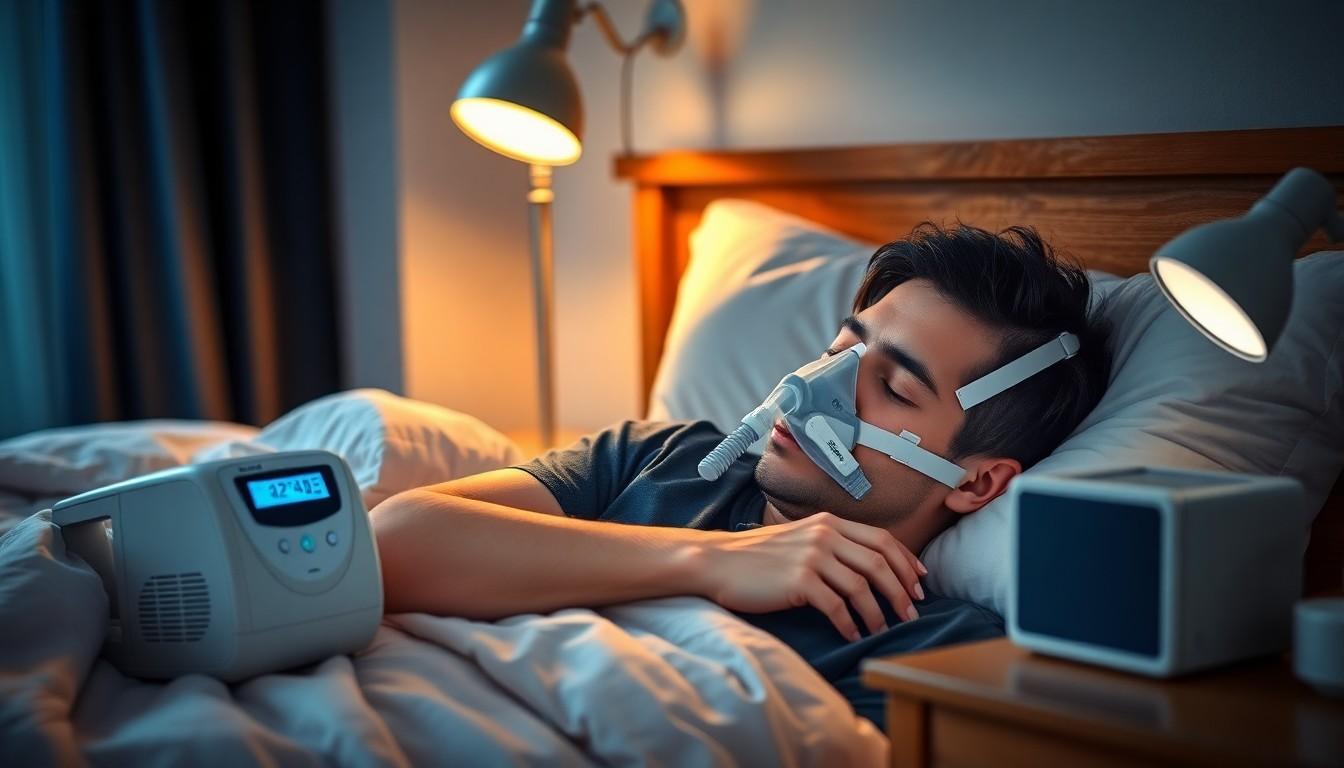
CPAP therapy revolutionizes sleep quality for individuals with obstructive sleep apnea by delivering continuous pressurized air throughout the night. These life-changing devices offer multiple advantages that extend beyond basic sleep improvement.
Improved Sleep Quality
- Uninterrupted Sleep Patterns: CPAP machines maintain open airways, eliminating the 5-30 breathing pauses per hour common in sleep apnea patients.
- Enhanced Deep Sleep: Users experience 7-8 hours of continuous rest, compared to fragmented sleep patterns without CPAP therapy.
- Reduced Snoring: The pressurized airflow prevents tissue vibration, resulting in quieter sleep for both users and bed partners.
- Better Sleep Architecture: Users achieve proper sleep cycles, including essential REM sleep stages critical for cognitive function.
- Cardiovascular Benefits:
- Reduces high blood pressure by 2-3 points
- Decreases risk of heart disease by 50%
- Lowers stroke risk by 40%
- Metabolic Improvements:
- Stabilizes blood sugar levels
- Enhances insulin sensitivity
- Supports weight management goals
- Mental Health Benefits:
- Improves concentration by 40%
- Reduces depression symptoms in 73% of users
- Decreases anxiety levels by 50%
| Health Metric | Improvement with CPAP |
|---|---|
| Blood Pressure | 2-3 point reduction |
| Heart Disease Risk | 50% decrease |
| Stroke Risk | 40% decrease |
| Depression Symptoms | 73% reduction |
| Concentration | 40% improvement |
The CPAP therapy success rate reaches 90% when users maintain consistent nightly use, adhering to prescribed pressure settings. Regular use leads to noticeable improvements within 2-3 weeks of starting therapy.
Choosing the Right CPAP Machine
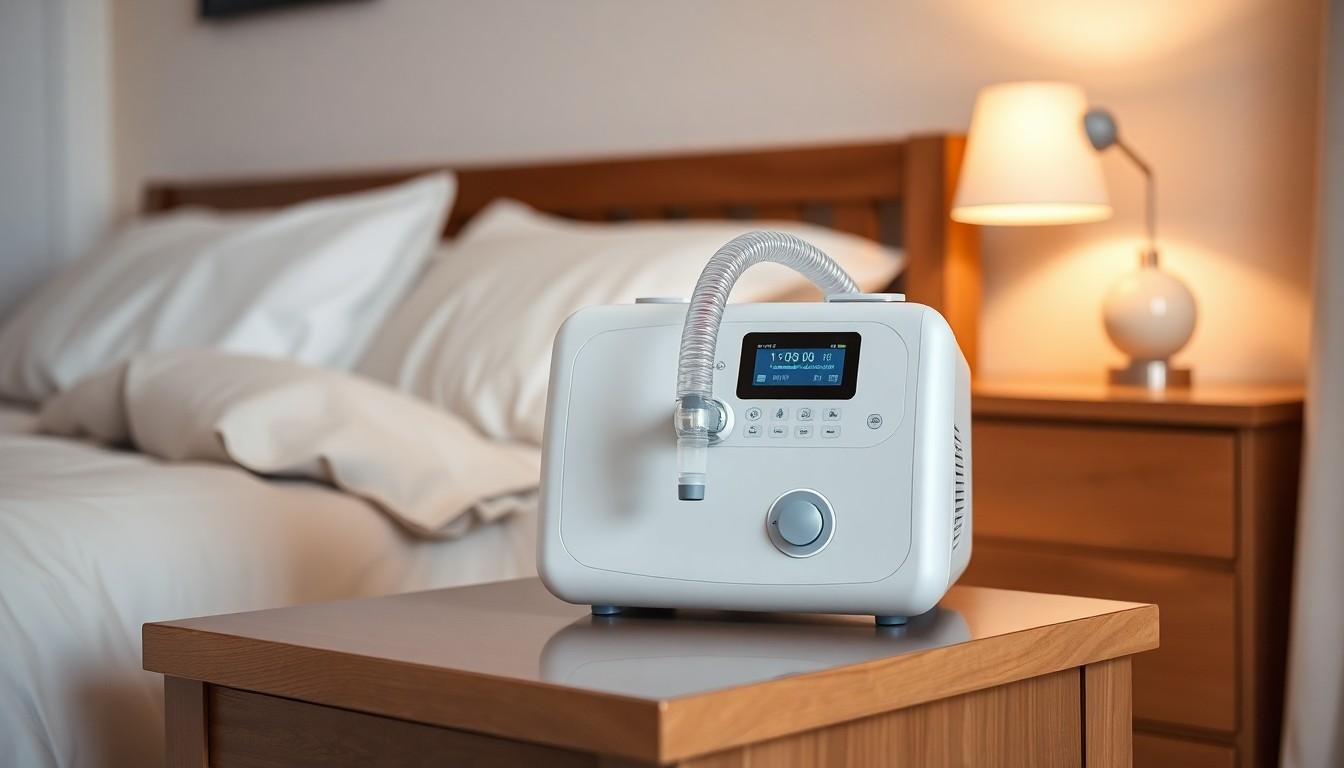
Selecting an appropriate CPAP machine requires careful consideration of specific features that match your sleep therapy needs. Understanding the key aspects helps narrow down the options for optimal treatment outcomes.
Important Features to Consider
CPAP machines come with essential features that enhance therapy effectiveness. The VortexPAP technology eliminates the need for tight-fitting masks through innovative vortex airflow design. Modern CPAP devices include automatic pressure adjustment capabilities that optimize air pressure throughout sleep cycles. Key features to evaluate include:
- Pressure range compatibility with prescribed settings
- Noise levels measured in decibels
- Built-in humidification systems
- Data tracking capabilities
- Mask compatibility options
- Filter type specifications
- Machine size dimensions
Cost and Insurance Coverage
CPAP machines vary in price based on features included. Insurance coverage options impact out-of-pocket expenses for equipment purchases:
| Coverage Type | Typical Coverage Range |
|---|---|
| Medicare | 80% of approved amount |
| Private Insurance | 50-90% coverage |
| HSA/FSA | 100% eligible expense |
Cost considerations include:
- Initial equipment purchase
- Replacement supplies (masks, tubes, filters)
- Extended warranty options
- Service maintenance fees
- Travel battery packs
- Cleaning accessories
- Monthly supply subscriptions
The total investment ranges from $500 to $3,000, depending on machine specifications. Insurance pre-authorization requirements determine coverage eligibility. Rental programs offer trial periods before committing to purchase.
Maintaining Your CPAP Device
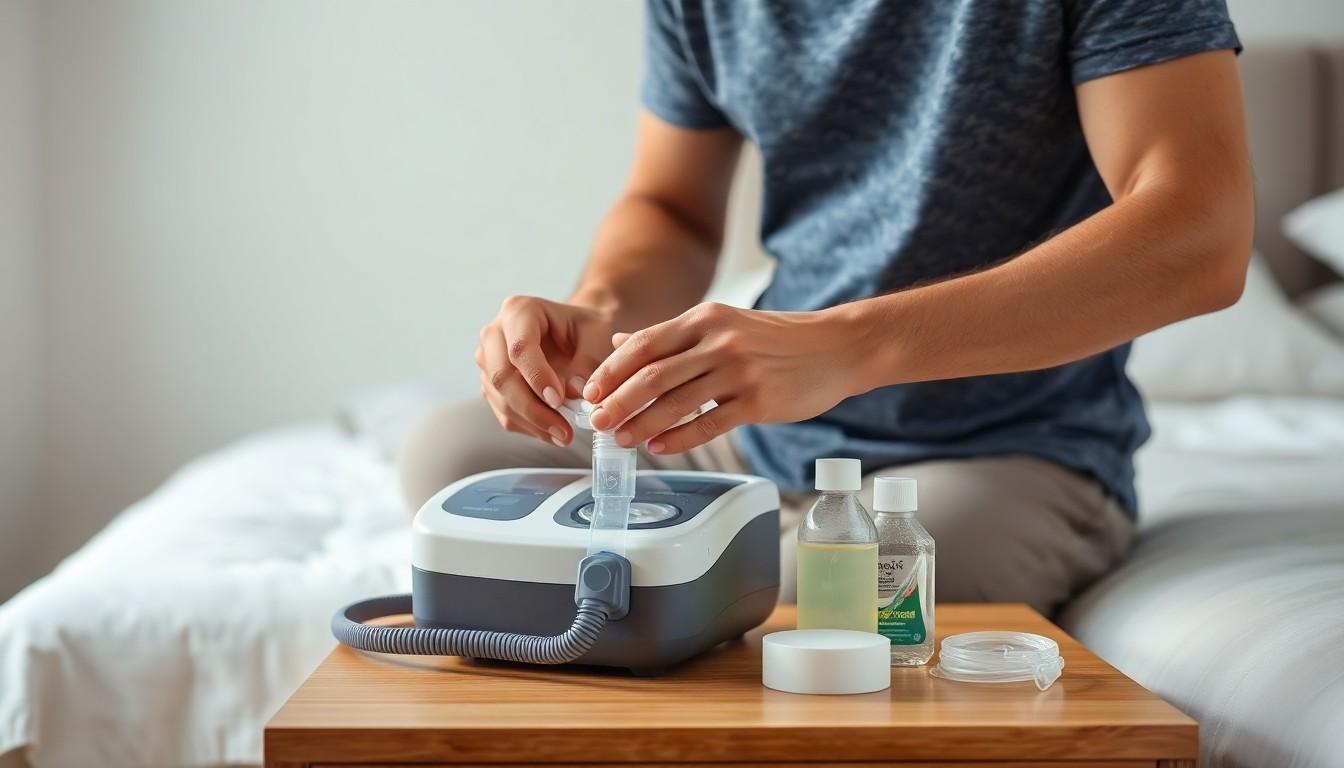
Regular maintenance keeps your CPAP device performing optimally while ensuring hygiene standards for safe therapy. A well-maintained CPAP machine provides consistent air pressure delivery essential for effective sleep apnea treatment.
Cleaning and Sanitization
Daily cleaning of CPAP components prevents bacteria buildup while extending CPAP equipment life. Here’s a breakdown of cleaning requirements:
Daily Tasks:
- Wipe mask cushion with CPAP wipes
- Empty humidifier chamber water
- Clean mask frame with mild soap solution
- Air dry mask components completely
Weekly Tasks:
- Soak tubing in warm soapy water for 30 minutes
- Wash humidifier chamber thoroughly
- Clean mask headgear with gentle soap
- Rinse all components with distilled water
For sanitization:
- Use vinegar solution (1:3 ratio with water)
- Follow manufacturer sanitization guidelines
- Avoid harsh chemicals or alcohol-based cleaners
- Allow components to dry completely before reassembly
Replacement Schedule
Critical CPAP components require regular replacement to maintain therapy effectiveness:
| Component | Replacement Frequency |
|---|---|
| Mask cushion | Every 1-3 months |
| Air filters | Every 2-4 weeks |
| Mask frame | Every 3-6 months |
| Tubing | Every 3-6 months |
| Headgear | Every 6 months |
| Water chamber | Every 6-12 months |
Factors affecting replacement timing:
- Usage frequency
- Local air quality
- Cleaning regularity
- Storage conditions
- Visible wear signs
- Discoloration
- Cracks or tears
- Loss of seal integrity
- Reduced performance
- Unusual odors
Common Issues and Troubleshooting

CPAP therapy brings specific challenges that impact its effectiveness. Understanding these issues enables quick identification and resolution to maintain optimal treatment benefits.
Mask Fit Problems
Finding the right mask fit creates the foundation for effective CPAP therapy. Here are the primary fit-related concerns:
- Mask Discomfort: A tight mask causes facial sores or pressure points while a loose mask creates air leaks that reduce therapy effectiveness
- Air Leaks: Gaps between the mask and face lead to escaped air directing toward eyes or creating whistling sounds
- Seal Issues: Facial hair prevents proper sealing of the mask cushion against skin
- Size Mismatch: Wrong mask size causes pressure points or gaps that compromise the seal
- Strap Tension: Uneven headgear adjustment creates asymmetrical pressure distribution
Solutions for mask fit issues:
- Try different mask styles (nasal, full-face, nasal pillows) to match your facial structure
- Adjust headgear straps while lying down in your sleeping position
- Replace worn cushions every 3-6 months to maintain proper seal
- Use mask liners or barrier creams to prevent skin irritation
Machine Performance Issues
Common operational problems affect CPAP machine functionality:
- Pressure Inconsistency: Fluctuating air pressure reduces therapy effectiveness
- Noise Level: Excessive machine noise disrupts sleep quality; exploring CPAP noise solutions can help minimize disturbances
- Water Condensation: Moisture accumulation in tubing causes gurgling sounds
- Filter Blockage: Dirty filters restrict airflow capacity
- Power Interruptions: Battery backup failure during power outages
Troubleshooting steps for machine issues:
- Check filter cleanliness monthly replace as needed
- Position machine below head level to prevent water condensation
- Use CPAP heated hose to reduce moisture accumulation
- Install surge protector to prevent power-related disruptions
- Schedule annual maintenance checks with equipment provider
Conclusion
CPAP machines have revolutionized sleep apnea treatment offering a reliable solution for better rest and improved health. With various types available from standard units to travel-friendly options you’ll find a device that fits your specific needs.
Making an well-informed choice about your CPAP machine involves considering features pressure settings and costs while understanding insurance coverage can help make the investment more manageable. Regular maintenance and proper troubleshooting ensure your device continues to provide effective therapy.
Remember that successful CPAP therapy requires commitment but the benefits – from better sleep to improved cardiovascular health – make it a worthwhile investment in your long-term wellbeing.
Frequently Asked Questions
What is a CPAP machine and how does it work?
A CPAP machine is a medical device that treats sleep apnea by delivering continuous pressurized air through a mask to keep your airways open during sleep. It works in three steps: taking in ambient air, pressurizing it to your prescribed level, and delivering it through a tube to your mask.
How much does a CPAP machine cost?
CPAP machines typically cost between $500 and $3,000, depending on features and type. Insurance often covers a portion of the cost, with Medicare covering 80% of approved amounts and private insurance covering 50-90%. Additional costs include replacement supplies and cleaning accessories.
What are the different types of CPAP machines?
There are three main types: Standard CPAP machines (fixed pressure), Auto-Adjusting CPAP (APAP) that automatically changes pressure based on your needs, and Travel CPAP machines designed for portability. Each type serves different user needs and preferences.
What are the benefits of using a CPAP machine?
CPAP therapy provides numerous benefits including improved sleep quality, reduced snoring, better cardiovascular health, stabilized blood sugar levels, and enhanced mental clarity. Users typically experience noticeable health improvements within weeks, with a 90% success rate for consistent users.
How often should I clean my CPAP machine?
Daily cleaning includes wiping the mask cushion and emptying the humidifier chamber, and following CPAP humidifier cleaning tips to prevent bacteria buildup.. Weekly cleaning involves soaking the tubing in warm soapy water. Regular maintenance ensures optimal performance and hygiene. Replace components like mask cushions, filters, and tubing according to the manufacturer’s schedule.
What are common CPAP machine problems and solutions?
Common issues include mask discomfort, air leaks, pressure inconsistency, and noise. Solutions include adjusting mask fit, trying different mask styles, checking for equipment damage, and ensuring proper maintenance. Most problems can be resolved through simple troubleshooting steps.
How do I choose the right CPAP machine?
Consider factors such as pressure range compatibility, noise levels, humidification features, data tracking capabilities, mask compatibility, and size. Consult with your healthcare provider to determine the best option based on your specific sleep apnea diagnosis and lifestyle needs.
Can I travel with my CPAP machine?
Yes, you can travel with a CPAP machine. Travel CPAP machines are specifically designed to be lightweight and portable CPAP option, often featuring integrated batteries. Regular CPAP machines can also be transported, but they’re typically larger and may require additional considerations for power supply.

